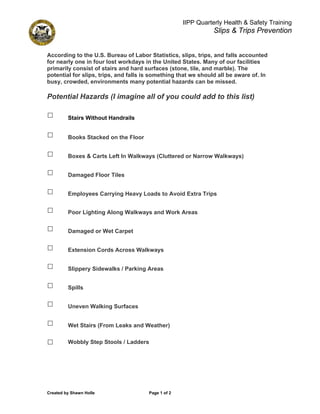Slip Trips Prevention Training
- 1. IIPP Quarterly Health & Safety Training Slips & Trips Prevention According to the U.S. Bureau of Labor Statistics, slips, trips, and falls accounted for nearly one in four lost workdays in the United States. Many of our facilities primarily consist of stairs and hard surfaces (stone, tile, and marble). The potential for slips, trips, and falls is something that we should all be aware of. In busy, crowded, environments many potential hazards can be missed. Potential Hazards (I imagine all of you could add to this list) Ō¢Ī Stairs Without Handrails Ō¢Ī Books Stacked on the Floor Ō¢Ī Boxes & Carts Left In Walkways (Cluttered or Narrow Walkways) Ō¢Ī Damaged Floor Tiles Ō¢Ī Employees Carrying Heavy Loads to Avoid Extra Trips Ō¢Ī Poor Lighting Along Walkways and Work Areas Ō¢Ī Damaged or Wet Carpet Ō¢Ī Extension Cords Across Walkways Ō¢Ī Slippery Sidewalks / Parking Areas Ō¢Ī Spills Ō¢Ī Uneven Walking Surfaces Ō¢Ī Wet Stairs (From Leaks and Weather) Ō¢Ī Wobbly Step Stools / Ladders Created by Shawn Holle Page 1 of 2
- 2. IIPP Quarterly Health & Safety Training Slips & Trips Prevention Reducing Risk: (Dealing with the Every Day) Ō¢Ī Work areas: Provide enough work space to avoid collisions. Redesign the layout to eliminate blind corners and areas of clutter. Ō¢Ī Materials storage: Provide proper storage so walkways and work areas are kept free of clutter. Ō¢Ī Tripping hazards: Keep electrical cords out of walkways. Maintain carpets in good condition. Replace Broken Floor Tiles. Ō¢Ī Slipping hazards: Install non-slip surfaces and handrails on stairs, and place non-slip floor mats at entrances and in wet areas. Work practices: Train workers not to move too quickly, not to carry items Ō¢Ī too tall to see over, and to warn other workers when they pass behind them. Ō¢Ī Understand Flood Control Procedures for Your Facility! Ō¢Ī Spills: Clean up spills immediately. Use signs to warn Employees of slippery floors. Reaching and climbing: Store frequently used items in accessible Ō¢Ī locations. Provide ladders and footstools, and keep them in good condition. Ō¢Ī Lighting: Keep work areas well lit Ō¢Ī Submit Timely Work Orders for Major Repairs Ō¢Ī Communicate All Housekeeping Issues to Custodial Services Created by Shawn Holle Page 2 of 2

